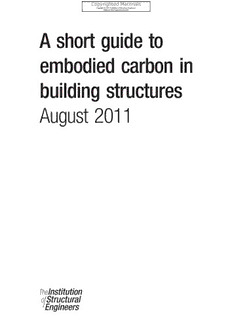
A short guide to embodied carbon in building structures PDF
Preview A short guide to embodied carbon in building structures
A short guide to embodied carbon in building structures August 2011 Acknowledgements Figures2and4courtesyofRamboll Figure5courtesyofArupandTheConcreteCentre PhotoofvelodromecourtesyofLondon2012 PhotoofBryghusprojektetcopyrightOMA PublishedbyTheInstitutionofStructuralEngineers InternationalHQ,11UpperBelgraveStreet,LondonSW1X8BH Telephone:þ44(0)2072354535Fax:þ44(0)2072354294 Email:[email protected],Website:www.istructe.org Firstpublished2011 ISBN978-1-906335-19-9 #2011TheInstitutionofStructuralEngineers TheInstitutionofStructuralEngineersandthoseindividualswhocontributedtothisGuidehave endeavoredtoensuretheaccuracyofitscontents.However,theguidanceandrecommendations givenintheGuideshouldalwaysbereviewedbythoseusingitinthelightofthefactsoftheir particularcaseandspecialistadviceobtainedasnecessary.Noliabilityfornegligenceorotherwisein relationtothisGuideanditscontentsisacceptedbytheInstitution,itsservantsoragents.Any personusingthisGuideshouldpayparticularattentiontotheprovisionsofthisCondition. Nopartofthispublicationmaybereproduced,storedinaretrievalsystemortransmittedinany formorbyanymeanswithoutpriorpermissionoftheInstitutionofStructuralEngineers,whomay becontactedat11UpperBelgraveStreet,LondonSW1X8BH. Foreword Thefirstdecadeofthe21stCenturywasmarkedby therapidlygrowingacceptancethattheworld’s climatewaschanging,andtheresultsofthese changeswouldhaveaprofoundlydamagingimpact ontheenvironmentandlargenumbersofpeople’s lives.Generallyagreementdevelopedrecognisingthe severityofthechangesbroughtaboutbyclimate changewouldberelativetotheabilityoftheworld’s populationstomitigatethecausesofthesechanges andinadaptingtoachangingenvironment.A landmarkagreementsettinglegallybindingtargetsfor carbonemissionsbyindustrialisedcountrieswas signedby174countriesinKyotoin1997,knownas theKyotoProtocol,theseagreementscameinto forcein2005.TheUKgovernmentpublishedthe SternReportin2006whichconsideredtheeconomic impactofclimatechangeontheUK.Thereport foundthatthecostsofactionfaroutweighedthe costsofinaction.IntheUK,November2008sawthe ClimateChangeBillenacted,withcommitmentsto reduceby80%of1990levels,carbondioxidegreen housegasemissionswithinaperiodof42years.The worldforum–COP15heldinCopenhagenin2009 reinforcedthedepthofconcernfeltgloballyatthe potentialofclimatechangetoimpactontheplanet anditspeoples. TheCounciloftheInstitutionofStructuralEngineers openlydebatedinOctober2009,thecontribution whichstructuralengineeringandspecificallythe Institutioncouldmaketothechallengeofglobal climatechangeandtheUKGovernment’s commitmenttoreducecarbondioxideemissions. Theoutcomefromthatdebatewasarequesttothe TrusteesoftheInstitutiontoconsideractionswhich couldbetakenwhichwouldempowerstructural engineerstomakeaneffectivecontributionto reducingtheimpactofclimatechange. ThisshortguideisadirectresultoftheTrustees considerationoftheCouncilsrequest.Thepublication wascommissioneddirectlybytheTrusteesofthe InstitutionofStructuralEngineersfromProfessor RogerPlank,formerHeadofSchoolofArchitecture atSheffieldUniversityandthethenSeniorVice- PresidentoftheInstitution. InproducingthisguidetheTrusteesweremindfulthat thesustainabilityaspectsofthebuiltenvironment, bestpracticeandlegislativeframeworks,differacross theinternationalspectrumandthatallwereevolving veryrapidly.Theguidancecontainedinthis publicationshouldbeconsideredasinteriminthis rapidlyevolvingfieldofknowledgeandtheTrustees contributiontofurtheringthenecessaryevolutionsto ourindustry. iv TheInstitutionofStructuralEngineersAshortguidetoembodiedcarboninbuildingstructures Contents Foreword iv 1 Aimandscope 1 1.1 Aim 1 1.2 Scope 1 2 Introduction 2 3 Whatisembodiedcarbonandembodiedenergy? 3 4 Dataforembodiedcarbonandenergy–lifecycle inventories(LCls) 4 5 Quantifyingembodiedcarbon 5 6 Sourcesofdata 6 7 Criticalassessmentofdata 8 7.1 Transparency 8 7.2 Differentiation 8 7.3 Currency 8 7.4 Variability 8 7.5 Energysources 9 7.6 Transportandsitework 9 7.7 Allowanceforrecycling 9 7.8 Allowanceforuseofwastematerialsandby- products 9 7.9 Allowanceformaterialswastedonsite 10 7.10 Treatmentofsequesteredcarbon 10 7.11 Carbonation 10 8 Somepracticaluses 11 8.1 Therelativeimportanceofembodiedcarbon 11 8.2 Baselines 11 8.3 Waste 12 8.4 Experience 12 8.5 Scope–whattoinclude 12 9 Conclusions 13 References 14 Bibliography 16 AppendixA–Workedexamples 17 TheInstitutionofStructuralEngineersAshortguidetoembodiedcarboninbuildingstructures iii 1 Aim and scope 1.1 Aim Thisshortguideisintendedtoprovidestructural engineerswithpracticaladviceonhowtheycan contributedirectlytoreducingtheembodiedcarbon/ energyfootprintoftheprojectstheydesign. Manystructuralengineershave‘signedup’tothe principlesofsustainableconstruction,butarenot surewhattheycandopractically,andmaybe frustratedbecausethestructuralengineerisnotthe naturalleaderforsomanyofthekeyissues–for example,theservicesengineerwillnormallyleadon thedesignandspecificationofbuildingenvironment systems(heating,cooling,ventilation)whichare energyintensive,whilstthearchitectwillgenerallybe responsibleforform,orientation,glazing,shadingetc. Whilstthestructuralengineershouldbeawareofall oftherelevantissues,mostwouldbeuncomfortable tryingtotakeresponsibilityforthese.Theintentionof thisguideistoconcentrateonjustthatpartofthe designwhichthestructuralengineercandirectly influence,namelytheembodiedenergyandcarbon associateddirectlywiththestructure. Ofcourse,embodiedenergyandcarbonshouldnot beconsideredinisolation,andthisguidewillinclude referencetootherrelevantissues–notably operationalenergy–withsomegeneralcomment abouttheirrelativeimportanceandpotentialtrade- offs.However,inmanycasesitispossibletomake clearreductionsintheembodiedcarbonwithout detrimenttoothermeasuresofsustainability;this shortguidewillprovidesomeguidanceonthis. 1.2 Scope Theguideisnotintendedtoprovideanyofthe following: – Adirectcomparisonofdifferentmaterialsand systems – Acomprehensivetreatmentofsustainable construction – Newdatafortheembodiedcarbonandenergyof differentmaterialsandproducts – Adetailedcommentaryoflifecycleassessment Theguideisshortinlength,thereforethereisclearly noroomtoconsiderthebroaderissuesof sustainabilityinanydetailnorisitintendedtoprovide newenergyorcarbondataformaterials.Thefocusis ondescribingwhatinformationandtoolsareavailable andhowthesecanbeappliedtoestimate,and subsequentlyactasavehicletoidentifywaysto reduceembodiedcarbon. TheInstitutionofStructuralEngineersAshortguidetoembodiedcarboninbuildingstructures 1 2 Introduction Thereareanumberofindicatorsandmeasures toexploringpotentialreductions.Duringtheinitial whichneedtobeconsideredinacomprehensive designphasesthereisthereforeaneedtoestablisha treatmentofsustainabledevelopment.Manyofthese quickestimatebasedongeneralinformationwithlittle areoutsidethedirectinfluenceofthestructural detail.Inthecontextofstructuraldesign,the engineer,butrecentlyattentionhasbecomecentred engineer’sexperienceenablesstructuralconceptsto onglobalwarmingandclimatechange,andwhatis bedevelopedtodefineform,layout,andtheprincipal widelyacceptedasbeingoneofthemajor materialswhichwillbeused.Withoutthesame contributorstothis,namelytheemissionofcarbon experienceofdoingthisforcarbonemissions, dioxide–oftenabbreviatedsimplytocarbon–into structuralengineersneedquickandeasytoolsto theatmosphere.Itshouldbenotedthatothergases performrelativelycrudecomparisonsofideas,and suchasmethane,nitrousoxideandHFCs thisguideprovidessomeguidanceonhowtodo (hydrofluorocarbons)alsocontributetoglobal this.Overtimebenchmarkdatawillhelpestablish warming.Insomecircumstances,emissionsofthese rulesofthumbforconceptdesign. othergreenhousegasescanbesignificant,for exampleagriculturalprocessescanoftencause Asthedesigndevelops,moredetailedcarbon methaneemissions(fromanimalsorfromsoil),nitrous calculationsarealsorequired.Atthelaterstages,the oxideisassociatedwiththeproductionofnylon,and calculationofembodiedcarboncanrequirealarge HFCsmaybeusedinthemanufactureofsome inputoftimeandresearchintoquantitiesandvalues insulants.Theglobalwarmingpotential(GWP)of formaterialsused.Whilstthismaybeoflessvaluein thesegasesismuchmoreseverethancarbon refiningthedesignconcept,detailedissuessuchas dioxide,butfortunatelythecorrespondingquantities materialspecification,particularlyforconcrete,can areverymuchlower.Whereappropriatetheireffect haveasignificantinfluenceontheembodiedcarbon. onglobalwarmingisgenerallyincludedinfiguresfor Amoredetailedanalysisofembodiedcarbonisalso embodiedcarbon,representedasacarbondioxide likelytobecomenecessaryasameansofcertifying equivalent. thecarbonfootprintofthebuilding.Increased experiencewill,intime,helpdefinehowmuchdetail Buildingshaveanextremelyimportantroletoplayin willberequired,andidentifythoseaspectswhichare thedrivetowardsalowcarboneconomy.Asan ofgreatestimportance,andotherswhichmayhavea example,in2009itisestimatedthatthedomestic negligibleinfluence. sectoraccountedfor28%ofUKenergydemand, consuming43.6milliontonnesofoilequivalentand causing16%ofUKCO emissions;thiscorresponds 2 to75.3milliontonnesCO equivalent1.Estimates 2 vary,butitisgenerallyagreedthatbetweenonethird Planning andahalfofallcarbondioxideemissionsare associatedwithbuildingconstructionandoperation inserviceasillustratedinFigure12. Concept Abuilding’scarbonfootprintdescribesitsoverall s impactintermsofcarbondioxideemissions. sult e Ectwwmaeossioratstnmhuniemsluemdtidhafdabeetinictnrlychatcguletouoirotnednehnsemeostorfitbtcuhvepoacee,rrtdrobiapoidienotrnsdoudncoclcifttfefohesastoerhscabteiopynnocprdgbnilnee,ucotr,iwaolfdointmhmiifnocicapagnluhotabdeintliursisnceiiaelgandallsfrtsinbbs,ws,gooohantcnhinc,ieadhwwetedhhdsiacthis sentativeness of EC R DetaTileendd Deersign Potential for reduction e isassociatedwiththeenergyusedtoservicethe pr e building,principallyforheating,ventilation,cooling R Construction andlighting.Embodiedcarbonandhowtoquantifyit, isthesubjectofthisshortguide. Ifthestructuraldesignistobeinformedbytheneed Use toreduceembodiedcarbon,itisimportantthatsome considerationisgivenveryearlyinthedesignprocess Figure2 Inordertoachievethebestresultsitisimportant thatembodiedcarbonestimatesareundertakenearlyinthe designprocess,althoughasignificantcontributioncanbemade Buildings 46% ateverystage Agriculture 1% Industrial processes 23% Transport 30% Figure1 Sourcesofcarbondioxideemissionsbysector 2 TheInstitutionofStructuralEngineersAshortguidetoembodiedcarboninbuildingstructures 3 What is embodied carbon and embodied energy? Inthecontextofconstruction,embodiedcarbon (oftenabbreviatedtoECorECO )isameasureofthe 2 carbondioxideemissionsassociatedwithcreating thebuildingfabric.Itshouldthereforeincludethe carbonemittedwhensourcingandprocessingraw materials,thatemittedtomanufacturetheminto constructionproducts,deliverthemtosite,and assemblethemtoformthebuilding.Ideallyitshould alsoallowforanyreplacementorrefurbishment duringthebuilding’slife,anddismantlingor demolitionattheendoflifeandrecycling.Ofcourse thismaybedifficulttopredictpreciselysoisoften accountedforsimplybyincludingapercentage increaseintheinitialcalculation.Howanappropriate allowanceshouldbemadeforsuchreplacementand refurbishmentisacentralpartoftheworkofthe EuropeanCENcommitteeTC350whichis developingaEuropeanstandardforfullbuildinglife cycleanalysis.Thiswillhopefullyleadtogreaterclarity andconsistencyoftreatment. Embodiedenergy(EE)isthecorrespondingmeasure ofenergyusedintheseprocesses.Theshiftfrom energytocarbonasaunittomeasuretheembodied impactofaproductormaterialisduetothegrowing importanceattachedtoglobalwarmingandclimate change.Inmanyinstancesthereisaclosecorrelation betweencarbonandenergysinceahighproportion ofman-madecarbonemissionsresultsfromthe burningoffossilfuels.Thisisparticularlythecase whenconsideringtheoperationalimpactofa building.However,insomecasessignificantcarbon emissionsoccurasaresultofthechemistryof productionforaparticularprocess.Themostobvious examplefortheconstructionsectoristheproduction ofcementwhichinvolvestheconversionofcalcium carbonatetocalciumoxide,withcarbondioxideasa by-product.Insuchcasesthetotalembodiedcarbon isthesumofthatassociatedwiththeenergyusedin manufacture,andthecarbondioxideemittedasa resultofthechemicalreactions.Thisisillustratedin Table1whichcomparesembodiedenergyand embodiedcarbonfiguresforthemostcommon structuralmaterials. Inaddition,differentenergysources,forexample nuclearandfossilfuels,canhavequitedifferent carbonfootprints,sincecarbonemissionsarenot necessarilydirectlyproportionaltoenergy consumption,andthisisillustratedinFigure3.The 1000 exactrelationshipdependsontheenergysourceand 900 DEFRAintheUKpublishesrelevantfactors4. 800 700 600 Table1 Typicalvaluesforembodiedenergyand 500 embodiedcarbonforcommonstructuralmaterials. 400 (Source:UniversityofBathICEv2.03) 300 200 Construction Embodiedenergy Embodiedcarbon 100 material (MJ/kg) (kgCO /kg) 2 0 CSteemelent 240..51 10..3773 Coal OilNatural gasGeothermal NucleaHrydroelectricPhotovoltaic Wind Brick 3.0 0.23 Figure3 IndicativelevelsofcarbondioxideemissionsperkWhassociatedwithdifferent Timber 10.0 0.3 energysources TheInstitutionofStructuralEngineersAshortguidetoembodiedcarboninbuildingstructures 3 4 Data for embodied carbon and energy – life cycle inventories (LCIs) Theembodiedcarbonandenergyforabasic Preciselywhichstagesofaproduct’slifeareincluded materialsuchassteelorcementcanbedetermined inLCIdatasetscanvary.Thisiswhatisreferredto byidentifyingalltherelevantproductionprocesses asthe‘systemboundaries’.Mostdataisquotedas includingtheextractionofrawmaterials, ‘cradle-to-gate’inwhichcaseitwillincludethe transportationandprocessing.Foreachsingle carbonemissionsassociatedwithallstagesfrom processstep,therawmaterialsused,energy extractionthroughprocessing,butexcludeany consumedetc.arequantified,andthe transportationtositeandsubsequentassembly.It correspondingimpactsaredetermined.Theseare will,however,generallyallowfortransportassociated typicallyrepresentedasMJ/kgandkgCO /kgfor withtheproductionprocessitself,soforexample,in 2 embodiedenergyandcarbonrespectively.Clearly thecaseofconcrete,the‘gate’isnormallythatofthe therecanbesignificantvariationsdependingonthe ready-mixplant.Manycarboncalculatorscombine processesusedbyindividualmanufacturer/ figuresforcradle-to-gate;thismeansthatinevitable suppliers,andtheparticularmaterialspecification– variationsintheimpactsassociatedwithtransportto forexamplestainlesssteelorcarbonsteel,and siteanddisposalattheendoflifeareavoided;these glulaminatedorsawntimber.Inthecaseof shouldbeconsideredseparately,takingintoaccount concrete,individualdatafortheconstituent relevantinformationsuchasthespecificproject aggregates,cementandwateriscombined.For location. buildingcomponentssuchasasteelbeamor reinforcingbar,additionalprocessingneedstobe Alternativeboundariesaresometimesusedincluding: included,andforcomponentssuchasprecast ‘cradle-to-grave’whichincludesallstagesfrom concreteunits,datafordifferentmaterialsneedsto extraction(‘cradle’),manufacture,installation,anduse becombined.Inthiswayembodiedcarbonand throughtodisposalphase(‘grave’);and‘cradle-to- energydatacanbedevelopedforthebasic cradle’,whichextendscradle-to-graveassessmentto elementscommonlyusedinconstruction.Thisdata allowforrecycling(seeFigure4).Theseboundaries formswhatisknownasaLifeCycleInventory(LCI) aremoreoftenappliedtoproductswhichdonot –adatabaseforarangeofmaterialsandbasic havethecomplexityofabuildingorstructure,and components,containinginformationsuchasthe wherethesubsequentimpactsareclearer(for emissionsofavarietyofpollutantsassociatedwith exampleconsumergoodsorproductssuchas, theproduct–andthisisanessentialpartof fridge/freezersorcomputers).Whatisimportantis calculatingembodiedcarbon. thatthesystemboundariesforthebasicdataare known,andthatallotherstagesthroughthelifecycle Whenconsideringalternativestructuralsystems, areconsidered,ensuringthatthereisnoduplication directcomparisonofthesefiguresisofcourse oromission;althoughinsomecasesitmaybe meaningless,becauseofthevariationinloadcarrying reasonabletoneglectaparticularstage,ortousea capabilitiesofdifferentmaterials–asteelbeamfor simplifiedallowance,forexamplesimplyaddinga examplewillgenerallybemuchlighterthanthe percentageincreasetoaccountfortransportationor equivalentreinforcedconcretebeamtoperformthe siteconstruction. samefunction.Itisthereforeimportanttoconsider thetotalembodiedenergy/embodiedcarbonforthe equivalentfunctionalunitsratherthansimply comparingtheseforthesamequantityofdifferent EXTRACTION materials. VE TE LETOTE GRA O SI RAD GA DrealetavafnotrparnocLeCsIsreesquthirreosudgehtoauiltedevceorynssitdaegreatoiofnthoeflaiflel MANUFACTURE E TO DLE T C oenfvairpornomdeunctta.lTahnisalryesqisuiorefsthaeqpuroandtuitcattitvoemeasurea TRANSPORTATION RADL CRA C rangeofimpacts,oftenincludingglobalwarming potential,ozonelayerdepletion,eutrophication,and CONSTRUCTION depletionofmineralsandfossilfuels.Itincludesall theproductionprocessesandservicesassociated withtheproductthroughitslifecycle. DISPOSAL Inordertoquantifythedifferentimpactsavery detailedknowledgeoftheprocessesinvolvedatthe Figure4 Schematicrepresentationofdifferentsystem variousstagesofproduction,theenergy(typeand boundaries quantity)usedandanychemicalchangeswhichmay giverisetocarbondioxideisclearlyrequired. Considerablereliancehasthereforebeenplacedon manufacturerstoundertakethisanalysisortoengage lifecycleassessmentexpertstodoso,ontheir behalf,andprovidethenecessarydata.Thishas beensupplementedbyindependentstudies,bothto generatenewdataandcheckthevalidityofindustry figures. 4 TheInstitutionofStructuralEngineersAshortguidetoembodiedcarboninbuildingstructures 5 Quantifying embodied carbon Atitssimplestlevel,theessentialcomponents requiredtoquantifyembodiedcarbonofabuilding areadatabaseofindividualmaterialemissions(kgs. ofcarbonperkgofmaterial)–asdetailedinaLife CycleInventory(LCI)–andquantitiesofmaterials. Thetotalembodiedcarbonisthenthesumofall buildingquantitiesbrokendownbymaterial,including anappropriateallowanceforsitewaste,multipliedby theirunitimpact. Inprincipletheprocessisthereforeverysimple,and canbeapplied,forexample,byenteringtotal quantitiesintoaspreadsheetcontainingembodied carbondataforallmaterialsorproducts–the difficultyisassemblingtheembodiedcarbondatafor eachmaterial.Anumberoforganisationshave developedLCIsbasedontheprinciplesoutlined above,andhavemadetheseavailableformore generaluse.Thisdatamaybepresentedforthe basicmaterialsandproductsofconstruction,but somesetsofdataarepresentedforcomponentsand systems.Thesemightinclude,forexample,a particularprecastfloorsystemaccountingfor concrete,steelandincludingthecastingprocess,or ahalfbrickmasonrywall,accountingforbothbricks andmortar.Insuchcasesthedatamaybe expressedinawaywhichisconsistentwithstandard methodsofmeasurementusedfornormalestimating, andusingappropriateunitssuchaskgs.ofcarbon dioxidepersq.m. TheInstitutionofStructuralEngineersAshortguidetoembodiedcarboninbuildingstructures 5 6 Sources of data Thereareonlyafewsuchinventoriesproviding circumstancessuggestadifferentvalueshouldbe sourcesofthismaterialdataandsomeoftheseare used,andnewinformationcanbeadded,givingboth notreadilyavailablebecausetheyformpartof flexibilityandtransparency.Asimilarcombinationof comprehensivelifecycleassessmentsoftware,orare economicandcarbondataforeverymaterialandunit forinternalusewithinaparticularorganisation. ofworkisincludedinTheInstitutionofCivil Engineer’slatesteditionofitsCivilEngineering Oneimpartial,openandfreelyavailableinventoryis StandardMethodofMeasurement–CESMM3 theInventoryofCarbonandEnergy(ICE)developed Carbon&PriceBook7. bytheUniversityofBath3,5.Thiscontainscradleto gatedataforbothembodiedenergyandcarbonand Aruphasadoptedasimilarapproach,andhasalso hasbeenlargelyassembledfrompublished includedfiguresrelevanttoproductsuppliers informationandlifecycleassessmentsprovidedbya outsidetheUK.Althoughthisdataisnotpublished varietyofsources.Thedatapresentedisasynthesis infullasaseparateinventory,itisintegratedinto ofamuchbroaderrangeofdatacollectedbythe thecommerciallyavailableOasysstructural authors;withindividualentriesbasedonanumberof software8.Thedataincludesmoreprecisefigures differentstudiesforeachmaterial.Inevitablydatafor fordifferentconcretespecificationswhichAruphas thesamematerialfromdifferentsourcesshowed usedinwholebuildingstudiesincollaborationwith somevariation–partlyasaresultofvariationsinLCA theConcreteCentre8–10.Thesestudiesshowed methodologies,butmoreparticularlybecauseofeven justhowmuchvariationtherecanbein largerdifferencesinproductionmethods.Theauthors calculationsforembodiedcarbonasaresultof havethereforehadtousetheirexpertjudgementto variationsinbothmaterialspecificationand presentexplicitvaluesratherthanadatarange,but methodologyasillustratedinFigure5.Thisled theresultsareconsistentwithotherdatabases.The naturallytotheconclusionthatitisimportantfor authorsalsoacknowledgethattheembodiedcarbon engineerstoconsiderthedetailedspecificationof datahasoftenhadtobecalculatedbasedon concreteratherthanusinggenericfiguresforthe publishedinformationonenergyandthismay material,withreductionsashighas200kgCO /m2 2 thereforecompromiseaccuracyalittle.Despitethese achievedinextremecases. reservationstheICEdatabaseisgenerallyrecognised asprovidinggoodqualitydatafortheUK,anditis BREhasderivedindependentembodiedcarbon freelyavailableinasuitableformat.Itistherefore figuresforstructuralandarchitecturalcomponents, widelyused,andanumberoforganisationshave ratherthanbasicmaterialsandthesearepublishedin useditasthebasisfordevelopingtheirowntoolsfor theGreenGuidetoSpecification11.Theinformationis estimatingembodiedcarbon,butaswithany categorisedbybuildingelementorsystem,anduses database,itslimitationsshouldbeunderstood.The alettergradingtorepresentthecombinationof inventoryappearstobeactivelyupdatedwith thirteendifferentenvironmentalimpacts,including revisionsappearingroughlyeveryyear,sousers embodiedcarbon.Thelatestedition(4th,pub.2009) shouldensuretheyhavethelatestversion.Abrief oftheguidedoesincludeabsolutevaluesof extractoftheICEdatabaseisshowninTable1. embodiedcarbonperfunctionalunit(typicallyone However,itshouldbenotedthatthedatabase squaremetreoffloororwall)ofdifferentsystems,but providesaconsiderabledegreeofrefinement,for examplequotingdifferentdataforparticularconcrete strengthsandspecifications. 450 Somecompanieshavepublishedtheirown inventories,sometimesbasedontheICE,butrefining 400 thedatatosuittheirownapplications. Range of data 350 associated with Asuspapnleemxeanmtipnlge,itMwoitthtMinadceDpoennadlednhtadsatuasewdhitchhetIhCeEy, 2g/m) 300 material specification k havesourcedthemselvesandinformationfrom O (2 250 manufacturers,tocreateadatabaseofcarbon C e dioxideemissionsforallactivitiesofconstruction al 200 work.Thisisincludedalongsideunitpricesinthe uctur 150 Range of data latesteditionoftheannualpricebookwhichthey Str associated with prepare6.Theinformationisrelatedtostandard 100 methodology methodsofmeasurementforestimatingmaterial quantities.Individualmaterialimpactshavetherefore 50 hadtobeprocessedandcombinedasnecessaryto 0 providedataforstandardelementsofconstruction. Allbasedataiscradle-to-gate,sotransportationto siteandotherdownstreamimpactsareignored,but Figure5 Variationsintheembodiedcarbonofthestructureof appropriateplantonsiteisincluded.Aswiththe awholereinforcedconcreteframedbuilding,principallyasa UniversityofBathdatabase,wheretheauthorshada resultofdifferencesinconcretespecification(CourtesyofArup). rangeofdataforaparticularproduct,theyused (Themethodologyforaccountingforrecyclabilityofsteeland somejudgementandpresentedasinglefigure.All thevariationsinmanufacturingmethodsusedisdiscussedin datacanbemodifiedbytheuserifparticular Section7) 6 TheInstitutionofStructuralEngineersAshortguidetoembodiedcarboninbuildingstructures
